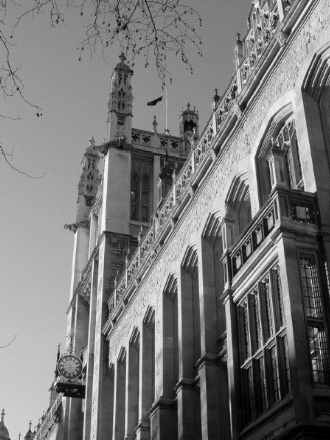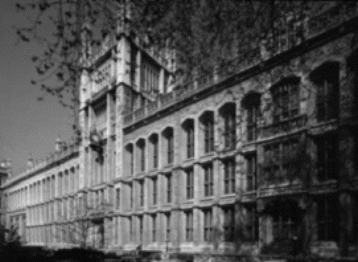
 The Mitre is the quality student newspaper at the University of St Andrews, the third-oldest university in the English-speaking world... more All correspondence should be sent to themitre@gmail.com. Editions of the Mitre generally are available online one month after they appear in print... more |
A R C H I T E C T U R E A New Library for King's The recent conversion of the former Public Record Office to a library for King’s College London is a fitting use of a building once dubbed ‘the strongbox of the nation’, and worthy of applause. by
NICHOLAS VINCENT
Vol. III, No. 6, June 24, 2005 Few
could fail to be impressed by the magisterial presence of the former
Public Record Office (PRO) in Chancery Lane, even though it has been
parcelled up since January of last year behind a carapace of steel
poles and polythene. Such is the form and scale of this palace of
towered ranges that, although Perpendicular Gothic decoration is
temporarily obscured, it remains possible still to appreciate that this
was the only state-funded major public building to follow in the style
of the Houses of Parliament.
 Begun in 1851, to a modified design by Sir James Pennethorne, this imposing yet functional model of Victorian civic architecture became in recent years the magnificent setting for King’s College Library. For years, the college’s major collections were dispersed at different sites around London, but are now amalgamated and relocated to a building that was purpose-designed to serve a similar function, housing the nation’s records. There is little doubt that the King’s Library is one of London’s finest. The site itself is of considerable historical significance, being associated with the Rolls of Chancery from 1377 and incorporating relics of the Rolls Chapel, founded in 1232. Contrary to what one might expect of a building designed as a repository for files and documents, its architectural history is fascinating. Geoffrey Tyack, the not entirely uncritical author of Sir James Pennethorne and the Making of Victorian London (1992) describes this early fire-proof building as ‘one of the most forward-looking buildings of its age’, although he sensed something of the workhouse or prison in its ‘overpowering massiveness’, and thought it ‘very intimidating, as it was presumably intended to be’. Pennethorne’s first block, consisting of eighty storage cells constructed of wrought-iron girders with shallow, brick-arched ceilings, established the building’s functional module. Each unit of a small, self-contained room, with iron door and slate shelving on metal racks, was expressed externally by a tall window of leaded lights between boldly projecting mullions, divided internally by a mezzanine, because there was not artificial lighting. ‘No conflagration could ever break out in a fire-proof Record Room’, the architect guaranteed.  While first approached from Fetter Lane, the building’s Gothic entrance lies at the centre if its south front, leading into a grand entrance hall with a painted zinc ceiling. Above this rises a tower, lower than originally intended, decorated with Perpendicular tracery, pierced parapets and polygonal turrets. Statues of four queens, coats of arms and gargoyles adorn its crown. A second phase, carried out between 1863 and 1868, consisted of an extension to accommodate more public spaces, including the ten-sided literacy search room, now known as the Round Reading Room. This fine example of cast-iron architecture, with two stories and a gallery top-lit by a glass dome, evokes Smirke’s reading room at the British Museum. Further blocks were added in 1869-71 and 1892-6, introducing to the building’s skyline its distinctive ogee turrets. The latter of these extensions, incorporating an arched gateway on its Chancery Lane façade, was designed by Sir John Taylor to house offices, a small library and a storeroom. The building was purchased by King’s College in 1998, two years after the PRO completed its move to Kew. In October 2001, a partial opening of the building allowed the public a glimpse of the refurbishment and conversion programme that was underway. More recently, however, with the building’s complete restoration, it is now obvious that although twenty-fives miles of slate shelving had to be removed and mezzanines rebuilt, the philosophy of the college and its architects, Gaunt Francis, was always to preserve the architectural form and spirit of this great Victorian institution, whilst equipping it with state-of-the-art library facilities. As well as the library collections of the college’s schools of humanities, law, and physical science and engineering, the library also houses rare books and special collections, which were previously located in Hampstead. These outstanding collections have been built up, largely by bequest or donations, since the founding of King’s College in 1829, and have grown to support its strength as one of London’s principal academic institutions. Among the special collections are the wealth of unusual 19th and 20th century publications, notably works on Ottoman history, Portuguese studies and the history of science (two first editions of Darwin’s On the Origin of Species, for example), and literary collections, including signed copies of works by Samuel Beckett and T. S. Eliot. Among the eleven thousand volumes in the rare books collection (mostly published before 1800) are early works of theology (particularly rare bibles), classical literature, travel, philology, early science and technology. First printed editions of the works of Homer (1488), Aristotle (1495-9) and Plato (1513) can be found here, together with an early copy of Ptolemy’s illustrated Geografia. Most significant of the collections is that of the great linguistic scholar and traveller William Marsden (1754-1836), presented to King’s in 1835. The library’s oldest book is a copy of Silius Italicus’ Punica, printed in Venice in 1483.  These Rare Books and Special Collections are housed in the Chancery Lane wing designed by Taylor. Here, the original appearance of the old PRO library, with its distinctive timber shelving is preserved. The ambitious restoration of this major public building as a centralised library for King’s College forms part of a remarkable £400 million redevelopment programme of the College’s estate. At present, about £5 million is still being sought for the library project by its appeal board, chaired by Tim Waterstone. Nicholas Vincent is a native Londoner with a keen eye and good taste. Return to Index T
H E M I T R E
THE QUALITY STUDENT NEWSPAPER AT THE UNIVERSITY OF ST ANDREWS |
C
O N T E N T S Home About Archives Literary Review On the Mitre: "Its frenetic tone is amusing in a relentless, unpitying way that reminds me of 'Vile Bodies'." Fr.
John Emerson
Regional Superior, FSSP |